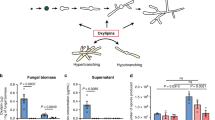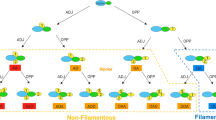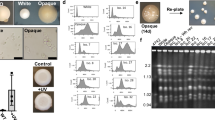Key Points
-
Fungal cells have two basic cellular morphologies: either yeast-like, such as Saccharomyces cerevisiae, or filamentous, such as Ashbya gossypii. Some fungi can switch from the yeast to the hyphal phase, and in the human fungal pathogen Candida albicans this morphogenetic switching is important in virulence.
-
The filamentous fungus A. gossypii is closely related to yeasts, as shown by its genome organization. Based on the phylogeny of genes such as rDNA, A. gossypii belongs to the family of Saccharomycetaceae. This means that A. gossypii is a suitable model for comparing the cell biology of filamentous fungi and yeasts.
-
Rho-protein modules are important regulators of the actin cytoskeleton and are involved in cell polarity establishment and the maintenance of hyphal growth. They are part of signalling networks that activate adaptor proteins that stimulate actin filament assembly.
-
The A. gossypii Wiskott–Aldrich syndrome protein homologue Wal1 has dual functions for endocytosis and vacuolar motility, and the localization of cortical actin patches, which are required for fast polarized cell growth.
-
Septation in filamentous fungi is different from cytokinesis in yeast, as it produces a septal pore that interconnects hyphal segments and therefore does not result in cell separation. In contrast to the S. cerevisiae Bud3, a central function of Bud3 in A. gossypii is the localization of the IQGAP-homologue Cyk1 to septal sites.
-
In conclusion, functional analyses of morphogenetic genes in yeast and a closely related filamentous fungus such as A. gossypii will provide new details on the general mechanisms of growth and septation and might also contribute to understanding how these processes evolved.
Abstract
Ashbya gossypii is a riboflavin-overproducing filamentous fungus that is closely related to unicellular yeasts such as Saccharomyces cerevisiae. With its close ties to yeast and the ease of genetic manipulation in this fungal species, A. gossypii is well suited as a model to elucidate the regulatory networks that govern the functional differences between filamentous growth and yeast growth, especially now that the A. gossypii genome sequence has been completed. Understanding these networks could be relevant to related dimorphic yeasts such as the human fungal pathogen Candida albicans, in which a switch in morphology from the yeast to the filamentous form in response to specific environmental stimuli is important for virulence.
This is a preview of subscription content, access via your institution
Access options
Subscribe to this journal
Receive 12 print issues and online access
$209.00 per year
only $17.42 per issue
Buy this article
- Purchase on Springer Link
- Instant access to full article PDF
Prices may be subject to local taxes which are calculated during checkout





Similar content being viewed by others
References
Ashby, S. F. & Nowell, W. The fungi of stigmatomycosis. Ann. Bot. 40, 69–84 (1926).
Wickerham, L. S., Flickinger, M. H. & Johnson, R. M. Production of riboflavin by Ashbya gossypii. Arch. Biochem. 9, 95–98 (1946).
Demain, A. L. Riboflavin overproducers. Annu. Rev. Microbiol. 26, 369–388 (1972).
Stahmann, K. P., Revuelta, J. L. & Seulberger, H. Three biotechnological processes using Ashbya gossypii, Candida famata, or Bacillus subtilis compete with chemical riboflavin production. Appl. Microbiol. Biotechnol. 53, 509–516 (2000).
Mickelson, M. M. The metabolism of glucose by Ashbya gossypii. J. Bacteriol. 59, 659–666 (1950).
Prillinger, H. et al. Phytopathogenic filamentous (Ashbya, Eremothecium) and dimorphic fungi (Holleya, Nematospora) with needle-shaped ascospores as new members within the Saccharomycetaceae. Yeast 13, 945–960 (1997). Phylogenetic analyses that demonstrate the close relationship of Ashbya spp. with the yeast family.
Wendland, J. & Philippsen, P. Determination of cell polarity in germinated spores and hyphal tips of the filamentous ascomycete Ashbya gossypii requires a rhoGAP homolog. J. Cell Sci. 113, 1611–1621 (2000).
Ayad-Durieux, Y., Knechtle, P., Goff, S., Dietrich, F. & Philippsen, P. A PAK-like kinase is required for maturation of young hyphae and septation in the filamentous ascomycete Ashbya gossypii. J. Cell Sci. 113, 4563–4575 (2000). This study describes the role of A. gossypii CLA4 in septation and growth promotion.
Stahmann, K. P. et al. Riboflavin, overproduced during sporulation of Ashbya gossypii, protects its hyaline spores against ultraviolet light. Environ. Microbiol. 3, 545–550 (2001).
Hicks, J. K., Yu, J. H., Keller, N. P. & Adams, T. H. Aspergillus sporulation and mycotoxin production both require inactivation of the FadA Gα-protein-dependent signalling pathway. EMBO J. 16, 4916–4923 (1997).
Wright, M. C. & Philippsen, P. Replicative transformation of the filamentous fungus Ashbya gossypii with plasmids containing Saccharomyces cerevisiae ARS elements. Gene 109, 99–105 (1991).
Steiner, S., Wendland, J., Wright, M. C. & Philippsen, P. Homologous recombination as the main mechanism for DNA integration and cause of rearrangements in the filamentous ascomycete Ashbya gossypii. Genetics 140, 973–987 (1995).
Schade, D., Walther, A. & Wendland, J. The development of a transformation system for the dimorphic plant pathogen Holleya sinecauda based on Ashbya gossypii DNA elements. Fungal Genet. Biol. 40, 65–71 (2003).
Wendland, J., Ayad-Durieux, Y., Knechtle, P., Rebischung, C. & Philippsen, P. PCR-based gene targeting in the filamentous fungus Ashbya gossypii. Gene 242, 381–391 (2000). This was the first demonstration of PCR-based transformation in a filamentous fungus.
Wendland, J. PCR-based methods facilitate targeted gene manipulations and cloning procedures. Curr. Genet. 44, 115–123 (2003).
Walther, A. & Wendland, J. Apical localization of actin patches and vacuolar dynamics in Ashbya gossypii depend on the WASP homolog Wal1p. J. Cell Sci. 117, 4947–4758 (2004). This study demonstrates the importance of actin patch positioning in polarized morphogenesis and endocytosis.
Gimeno, C. J., Ljungdahl, P. O., Styles, C. A. & Fink, G. R. Unipolar cell divisions in the yeast S. cerevisiae lead to filamentous growth: regulation by starvation and RAS. Cell 68, 1077–1090 (1992).
Braus, G. H., Grundmann, O., Bruckner, S. & Mosch, H. U. Amino acid starvation and Gcn4p regulate adhesive growth and FLO11 gene expression in Saccharomyces cerevisiae. Mol. Biol. Cell. 14, 4272–4284 (2003).
Berman, J. & Sudbery, P. E. Candida albicans: a molecular revolution built on lessons from budding yeast. Nature Rev. Genet. 3, 918–930 (2003).
Kahmann, R. & Kamper, J. Ustilago maydis: how its biology relates to pathogenic development. New Phytol. 164, 31–42 (2004).
Alberti-Segui, C., Dietrich, F., Altmann-Johl, R., Hoepfner, D. & Philippsen, P. Cytoplasmic dynein is required to oppose the force that moves nuclei towards the hyphal tip in the filamentous ascomycete Ashbya gossypii. J. Cell Sci. 114, 975–986 (2001). This study revealed nuclear distribution defects in dyn1 mutants that are strikingly different from similar mutations in A. nidulans.
Xiang, X., Beckwith, S. M. & Morris, N. R. Cytoplasmic dynein is involved in nuclear migration in Aspergillus nidulans. Proc. Natl Acad. Sci. USA 91, 2100–2104 (1994).
Willins, D. A., Xiang, X. & Morris, N. R. An α-tubulin mutation suppresses nuclear migration mutations in Aspergillus nidulans. Genetics 141, 1287–1298 (1995).
Plamann, M., Minke, P. F., Tinsley, J. H. & Bruno, K. S. Cytoplasmic dynein and actin-related protein Arp1 are required for normal nuclear distribution in filamentous fungi. J. Cell Biol. 127, 139–149 (1994).
Riquelme, M., Gierz, G. & Bartnicki-Garcia, S. Dynein and dynactin deficiencies affect the formation and function of the Spitzenkörper and distort hyphal morphogenesis of Neurospora crassa. Microbiology 146, 1743–1753 (2000).
Eshel, D. et al. Cytoplasmic dynein is required for normal nuclear segregation in yeast. Proc. Natl Acad. Sci. USA 90, 11172–11176 (1993).
Martin, R., Walther, A. & Wendland, J. Deletion of the dynein heavy chain gene DYN1 leads to aberrant nuclear positioning and defective hyphal development in Candida albicans. Euk. Cell 3, 1574–1588 (2004).
Matsui, Y. Polarized distribution of intracellular components by class V myosins in Saccharomyces cerevisiae. Int. Rev. Cytol. 229, 1–42 (2003).
Pruyne, D., Legesse-Miller, A., Gao, L., Dong, Y. & Bretscher, A. Mechanisms of polarized growth and organelle segregation in yeast. Annu. Rev. Cell. Dev. Biol. 20, 229–591 (2004).
Wendland, J. & Philippsen, P. Cell polarity and hyphal morphogenesis are controlled by multiple rho-protein modules in the filamentous ascomycete Ashbya gossypii. Genetics 157, 601–610 (2001). This is the first description of the role of multiple Rho GTPases in different stages of hyphal morphogenesis
Lew, D. J. & Reed, S. I. Morphogenesis in the yeast cell cycle: regulation by Cdc28 and cyclins. J. Cell Biol. 120, 1305–1320 (1993).
Zheng, X. & Wang, Y. Hgc1, a novel hypha-specific G1 cyclin-related protein regulates Candida albicans hyphal morphogenesis. EMBO J. 23, 1845–1856 (2004).
Bachewich, C. & Whiteway, M. Cyclin Cln3p links G1 progression to hyphal and pseudohyphal development in Candida albicans. Euk. Cell 4, 95–102 (2005).
Riquelme, M., Fischer, R. & Bartnicki-Garcia, S. Apical growth and mitosis are independent processes in Aspergillus nidulans. Protoplasma 222, 211–215 (2003).
Wendland, J. Comparison of morphogenetic networks of filamentous fungi and yeast. Fungal Genet. Biol. 34, 62–83 (2001).
Madden, K. & Snyder, M. Cell polarity and morphogenesis in budding yeast. Annu. Rev. Microbiol. 52, 687–744 (1998).
Bauer, Y., Knechtle, P., Wendland, J., Helfer, H. & Philippsen, P. A Ras like GTPase is involved in hyphal growth guidance in the filamentous fungus Ashbya gossypii. Mol. Biol. Cell 15, 4622–4632 (2004). This study incorporates signalling components upstream and downstream of Rho GTPases in the morphogenetic network.
Wedlich-Soldner, R., Altschuler, S., Wu, L. & Li, R. Spontaneous cell polarization through actomyosin-based delivery of the Cdc42 GTPase. Science 299, 1231–1235 (2003).
Caviston, J. P., Tcheperegine, S. E. & Bi, E. Singularity in budding: a role for the evolutionary conserved small GTPase Cdc42p. Proc. Natl Acad. Sci. USA 99, 12185–12190 (2002).
Johnson, D. I. Cdc42: an essential Rho-type GTPase controlling eukaryotic cell polarity. Microbiol. Mol. Biol. Rev. 63, 54–105 (1999).
Bender, A. & Pringle, J. R. Multicopy suppression of the cdc24 budding defect in yeast by CDC42 and three newly identified genes including the ras-related gene RSR1. Proc. Natl Acad. Sci. USA 86, 9976–9980 (1989).
Gulli, M. P. et al. Phosphorylation of the Cdc42 exchange factor Cdc24 by the PAK-like kinase Cla4 may regulate polarized growth in yeast. Mol. Cell 6, 1155–1167 (2000).
Bose, I. et al. Assembly of scaffold-mediated complexes containing Cdc42p, the exchange factor Cdc24p, and the effector Cla4p required for cell cycle-regulated phosphorylation of Cdc24p. J. Biol. Chem. 276, 7176–7186 (2001).
Yamochi, W. et al. Growth site localization of Rho1 small GTP-binding protein and its involvement in bud formation in Saccharomyces cerevisiae. J. Cell Biol. 125, 1077–1093 (1994).
Kamada, Y. et al. Activation of yeast protein kinase C by Rho1 GTPase. J. Biol. Chem. 271, 9193–9196 (1996).
Adamo, J. E., Rossi, G. & Brennwald, P. The Rho GTPase Rho3 has a direct role in exocytosis that is distinct from its role in actin polarity. Mol. Biol. Cell 10, 4121–4133 (1999).
Sheu, Y. J., Santos, B., Fortin, N., Costigan, C. & Snyder, M. Spa2p interacts with cell polarity proteins and signaling components involved in yeast cell morphogenesis. Mol. Cell Biol. 18, 4053–4069 (1998).
Fujiwara T. et al. Rho1p–Bni1p–Spa2p interactions: implication in localization of Bni1p at the bud site and regulation of the actin cytoskeleton in Saccharomyces cerevisiae. Mol. Biol. Cell 9, 1221–1233 (1998).
Knechtle, P., Dietrich, F. & Philippsen, P. Maximal polar growth depends on the polarisome component AgSpa2 in the filamentous fungus A. gossypii. Mol. Biol. Cell 14, 4140–4154 (2004).
Sagot, I., Klee, S. K. & Pellman, D. Yeast formins regulate cell polarity by controlling the assembly of actin cables. Nature Cell Biol. 4, 42–50 (2002).
Dong, Y., Pruyne, D. & Bretscher, A. Formin-dependent actin assembly is regulated by distinct modes of Rho signaling in yeast. J. Cell Biol. 161, 1081–1092 (2003).
Li, R. Bee1, a yeast protein with homology to Wiscott–Aldrich syndrome protein, is critical for the assembly of cortical actin cytoskeleton. J. Cell Biol. 136, 649–658 (1997).
Walther, A. & Wendland, J. Polarized hyphal growth in Candida albicans requires the Wiskott–Aldrich syndrome protein homolog Wal1p. Euk. Cell 3, 471–482 (2004).
Walther, A. & Wendland, J. Septation and cytokinesis in fungi. Fungal Genet. Biol. 40, 187–196 (2003).
Kadota, J., Yamamoto, T., Yoshiuchi, S., Bi, E. & Tanaka, K. Septin ring assembly requires concerted action of polarisome components, a PAK kinase Cla4p, and the actin cytoskeleton in Saccharomyces cerevisiae. Mol. Biol. Cell 15, 5329–5345 (2004).
Longtine, M. S. et al. The septins: roles in cytokinesis and other processes. Curr. Opin. Cell Biol. 8, 106–119 (1996).
Wendland, J. Analysis of the landmark protein Bud3 of Ashbya gossypii reveals a novel role in septum construction. EMBO Rep. 4, 200–204 (2003). This study demonstrates different roles for Bud3 homologues in S. cerevisiae and A. gossypii.
Wendland, J. & Philippsen, P. An IQGAP-related protein, encoded by AgCYK1, is required for septation in the filamentous fungus Ashbya gossypii. Fungal Genet. Biol. 37, 81–88 (2002).
Osman, M. A., Konopka, J. B. & Cerione, R. A. Iqg1p links spatial and secretion landmarks to polarity and cytokinesis. J. Cell Biol. 159, 601–611 (2002).
Dobbelaere, J. & Barral, Y. Spatial coordination of cytokinetic events by compartmentalization of the cell cortex. Science 305, 393–396 (2004).
Dietrich, F. S. et al. The Ashbya gossypii genome as a tool for mapping the ancient Saccharomyces cerevisiae genome. Science 304, 304–307 (2004).
Brachat, S. et al. Reinvestigation of the Saccharomyces cerevisiae genome annotation by comparison to the genome of a related fungus: Ashbya gossypii. Genome Biol. 4, R45 (2003).
Kellis, M., Birren, B. W. & Landers, E. S. Proof and evolutionary analysis of ancient genome duplication in the yeast Saccharomyces cerevisiae. Nature 428, 617–624 (2004).
Colman-Lerner, A., Chin, T. E. & Brent, R. Yeast Cbk1 and Mob2 activate daughter-specific genetic programs to induce asymmetric cell fates. Cell 107, 739–750 (2001).
Takaya, N., Yamazaki, D., Horiuchi, H., Ohta, A. & Takagi, M. Cloning and characterization of a chitinase-encoding gene (chiA) from Aspergillus nidulans, disruption of which decreases germination frequency and hyphal growth. Biosci. Biotechnol. Biochem. 62, 60–65 (1998).
Baggett, J. J., D'Aquino, K. E. & Wendland, B. The Sla2p talin domain plays a role in endocytosis in Saccharomyces cerevisiae. Genetics 165, 1661–1674 (2003).
Gourlay, C. W. et al. An interaction between Sla1p and Sla2p plays a role in regulating actin dynamics and endocytosis in budding yeast. J. Cell Sci. 116, 2551–2564 (2003).
Butler, G. et al. Evolution of the MAT locus and its Ho endonuclease in yeast species. Proc. Natl Acad. Sci. USA 101, 1632–1637 (2004).
Seo, J. A., Han, K. H. & Yu, J. H. The gprA and gprB genes encode putative G protein-coupled receptors required for self-fertilization in A. nidulans. Mol. Microbiol. 53, 1611–1623 (2004).
Altmann-Johl, R. & Philippsen, P. AgTHR4, a new selection marker for transformation of the filamentous fungus Ashbya gossypii, maps in a four-gene cluster that is conserved between A. gossypii and Saccharomyces cerevisiae. Mol. Gen. Genet. 250, 69–80 (1996).
Wendland, J. Eigenschaften linearer und zirkulärer DNA–Moleküle im filamentösen Pilz Ashbya gossypii. Diploma thesis, Univ. Giessen, Germany (1993).
Acknowledgements
The authors would like to thank the members of the Wendland and Philippsen labs for stimulating discussions. Research on A. gossypii in J.W.'s laboratory is supported by the Deutsche Forschungsgemeinschaft.
Author information
Authors and Affiliations
Corresponding author
Ethics declarations
Competing interests
The authors declare no competing financial interests.
Related links
Related links
FURTHER INFORMATION
Glossary
- STIGMATOMYCOSIS
-
A fungal infection resulting in wet, slimy kernels. It is transmitted by insect mouthparts that penetrate the kernel.
- ISOTROPIC GROWTH PHASE
-
Non-polarized growth over the entire cell surface during spore germination.
- SPORANGIUM
-
Cell or organ that produces or contains spores.
- SYNNEMA/-TA
-
Erect hyphae that are grouped together. Conidia might be formed along the length of the synnema or just at its apex.
- BIOTROPHIC PHASE
-
The pathogen invades host tissue without killing host cells and feeds on living cells.
- SPITZENKÖRPER
-
A phase-dark, usually spherical body that is found in growing hyphal tips, and represents an accumulation of secretory vesicles — also known as the vesicle supply centre.
- POLARISOME
-
Protein complex that consists, in S. cerevisiae, of the formin Bni1, Spa2, Bud6 and Pea2, and is involved in organization of the actin cytoskeleton and required for polarized cell growth.
- CORTICAL CUES
-
Membrane-associated proteins that function as landmarks to direct protein complexes that are required for the establishment of cell polarity.
- SYNTENY
-
Evolutionary conservation of gene order (including their transcriptional orientation) between two loci.
- CONIDIOPHORE
-
Structure that bears and generates the conidiospores.
Rights and permissions
About this article
Cite this article
Wendland, J., Walther, A. Ashbya gossypii: a model for fungal developmental biology. Nat Rev Microbiol 3, 421–429 (2005). https://doi.org/10.1038/nrmicro1148
Published:
Issue Date:
DOI: https://doi.org/10.1038/nrmicro1148
This article is cited by
-
Non-model model organisms
BMC Biology (2017)
-
Optimized sample preparation for single-molecule localization-based superresolution microscopy in yeast
Nature Protocols (2015)
-
Genome-wide metabolic re-annotation of Ashbya gossypii: new insights into its metabolism through a comparative analysis with Saccharomyces cerevisiae and Kluyveromyces lactis
BMC Genomics (2014)
-
A developmental stage of hyphal cells shows riboflavin overproduction instead of sporulation in Ashbya gossypii
Applied Microbiology and Biotechnology (2013)
-
Protein-based biorefining: metabolic engineering for production of chemicals and fuel with regeneration of nitrogen fertilizers
Applied Microbiology and Biotechnology (2013)



